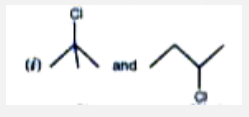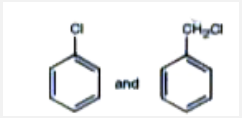Which is more unstable of each of the following pairs, and in each case what type of process could the unstable nucleus undergo?
F18, .10Ne18
To determine which of the two isotopes, F18 (Fluorine-18) or Ne18 (Neon-18), is more unstable and what type of decay process the unstable nucleus could undergo, we will follow these steps:
Step 1: Identify the atomic numbers and mass numbers
- For F18:
- Atomic number (Z) = 9 (Fluorine)
- Mass number (A) = 18
- For Ne18:
- Atomic number (Z) = 10 (Neon)
- Mass number (A) = 18
Step 2: Calculate the number of protons and neutrons
- For F18:
- Number of protons = 9
- Number of neutrons = Mass number - Atomic number = 18 - 9 = 9
- For Ne18:
- Number of protons = 10
- Number of neutrons = Mass number - Atomic number = 18 - 10 = 8
Step 3: Calculate the neutron-to-proton ratio (N/P)
- For F18:
- N/P ratio = Number of neutrons / Number of protons = 9 / 9 = 1
- For Ne18:
- N/P ratio = Number of neutrons / Number of protons = 8 / 10 = 0.8
Step 4: Analyze stability based on N/P ratio
- According to nuclear stability rules, for nuclei with atomic numbers up to 20, a neutron-to-proton ratio of approximately 1 is considered stable.
- F18 has an N/P ratio of 1, indicating it is stable.
- Ne18 has an N/P ratio of 0.8, indicating it is unstable.
Step 5: Determine the decay process for the unstable nucleus
- Since Ne18 is unstable and has a lower neutron-to-proton ratio, it will undergo a process to increase its N/P ratio.
- The likely decay process for Ne18 is beta plus (β+) decay, where a proton is converted into a neutron, emitting a positron and a neutrino. This will increase the neutron count and decrease the proton count, moving towards a more stable configuration.
Conclusion
- More unstable nucleus: Ne18 (Neon-18)
- Type of decay process: Beta plus (β+) decay
- For F18:
- Atomic number (Z) = 9 (Fluorine)
- Mass number (A) = 18
- For Ne18:
- Atomic number (Z) = 10 (Neon)
- Mass number (A) = 18
- For F18:
- Number of protons = 9
- Number of neutrons = Mass number - Atomic number = 18 - 9 = 9
- For Ne18:
- Number of protons = 10
- Number of neutrons = Mass number - Atomic number = 18 - 10 = 8
- For F18:
- N/P ratio = Number of neutrons / Number of protons = 9 / 9 = 1
- For Ne18:
- N/P ratio = Number of neutrons / Number of protons = 8 / 10 = 0.8
- According to nuclear stability rules, for nuclei with atomic numbers up to 20, a neutron-to-proton ratio of approximately 1 is considered stable.
- F18 has an N/P ratio of 1, indicating it is stable.
- Ne18 has an N/P ratio of 0.8, indicating it is unstable.
- Since Ne18 is unstable and has a lower neutron-to-proton ratio, it will undergo a process to increase its N/P ratio.
- The likely decay process for Ne18 is beta plus (β+) decay, where a proton is converted into a neutron, emitting a positron and a neutrino. This will increase the neutron count and decrease the proton count, moving towards a more stable configuration.
- More unstable nucleus: Ne18 (Neon-18)
- Type of decay process: Beta plus (β+) decay
Topper's Solved these Questions
- NUCLEAR CHEMISTRYBOOK - CENGAGE CHEMISTRY ENGLISHCHAPTER - NUCLEAR CHEMISTRYEXERCISE - Solved Example
18 Videos
- NUCLEAR CHEMISTRYBOOK - CENGAGE CHEMISTRY ENGLISHCHAPTER - NUCLEAR CHEMISTRYEXERCISE - Ex6.1 Objective
15 Videos
- NCERT BASED EXERCISEBOOK - CENGAGE CHEMISTRY ENGLISHCHAPTER - NCERT BASED EXERCISEEXERCISE - Nuclear Chemistry (NCERT Exercise)
29 Videos
- ORGANIC COMPOUNDS WITH FUNCTIONAL GROUPBOOK - CENGAGE CHEMISTRY ENGLISHCHAPTER - ORGANIC COMPOUNDS WITH FUNCTIONAL GROUPEXERCISE - Archives Analytical And Descriptive
24 Videos
Similar Questions
In which of the following pairs, 10g of each have an equal number of molecules?
View SolutionIn each of the following pairs of ions in which I ion is more stable than II
View SolutionIn each of the following pairs, which is more covalent and why?
AgCl and KCl
View SolutionIn each of the following pairs, which is more covalent and why?
LiCl and Lil
View SolutionIn each of the following pairs, which is more covalent and why?
LiCl and LiBr
View SolutionIn each of the following pairs of compounds, identify the compound which will undergo Sn1 reaction faster?

View SolutionIn each of the following pairs of compounds, identify the compound which will undergo Sn1 reaction faster?

View SolutionDraw a pair of isomers for each of the following and name the type of isomerism :∗∗
C4H10
View SolutionDraw a pair of isomers for each of the following and name the type of isomerism :∗∗
C4H10O
View SolutionWhich element in each of the following pairs would you expect to have higher first ionisation energy and why?
F ,Cl
View Solution
